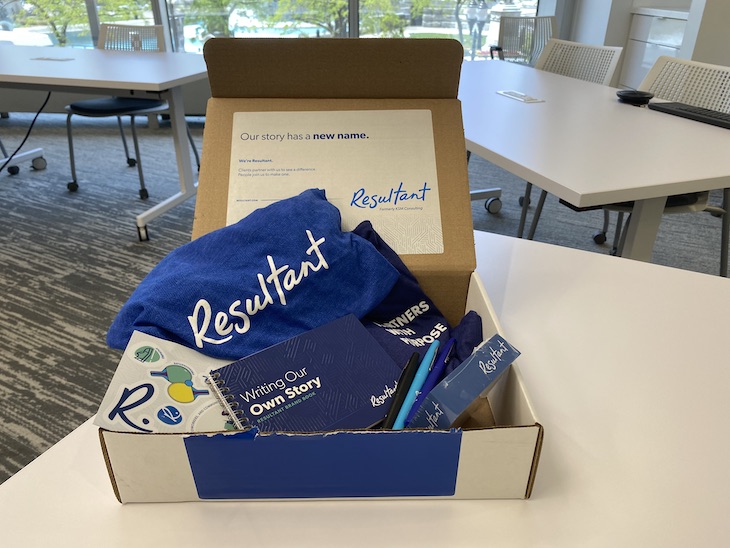3 Questions: Rebranding Authentically and Empathetically with Mary Catharine Grau
This is another installment in our “3 Questions” series contributed by subject matter experts throughout the tech community in Indiana. This series takes complex tech topics and explains them in easy-to-understand ways without the dense jargon so every reader can learn a little bit more about our industry.
A brand is not a name or a logo but everything that comes together to form a perception. And when it comes to rebranding—or, in our case, establishing our first independent brand—bringing that perception to life takes empathy, intentionality, and a healthy dose of change management.
How do you go about developing a brand that looks and feels authentic, internally and externally?
First, you have to know who you are and be able to tell your story in a way that feels authentic to clients and especially to employees. We approached the process like we would a client project: starting from a place of empathy. We held focus groups with employees and clients from all sides of the business to understand the perceptions of our brand from every angle. We asked questions like:
- What will you miss about the current brand?
- What feels true about the current brand? What doesn’t?
- What do you love about working at/with the organization?
- What kind of impact do you make with clients? Your communities?
We asked, and we listened, because authenticity was the objective. Like CEO Mark Caswell wrote in an IBJ column about the value of employee-led brands: “a brand should not only tell people on the outside who the organization is; it should also remind those inside why it exists. That’s why the brands that ring true are those that represent employee perspectives, experiences and values.“
We couldn’t have done it without the right partner. We talked to a number of impressive partners and, ultimately, chose JDA Worldwide, because they had experience developing values-driven brands and their beliefs about the role a brand can and should play were completely aligned with ours.
How do you engage employees in the process of rebranding?
We didn’t want the rebrand to feel like something that was happening to our employees. It’s a representation of who they are, the way they show up for our clients and communities, and the impact they make. It’s for them, and so we involved them in every step, encouraging them to feel some ownership of the brand even as it was being created. How else could we represent what’s authentic and true about the company they were helping to build?
Along with gathering their perspectives in interviews and focus groups, we enlisted a “brand champion” from every major area of our company. Each brand champion served as a representative of that business area and helped us with everything from transitioning documents to choosing our roll-out t-shirt designs.
Ensuring our team would feel ownership of the brand meant focusing on communication and change management—involving the team where we could and artfully communicating developments outside their engagement. That meant a lot of fun, visual email updates, storytelling and documentation training, fun unveilings, and a contest to choose our new team nickname.
A few secrets and surprises were inevitable, but we brought in employees as early and often as we could. Closer to launch, we started rolling things out more frequently, holding more contests, and creating special experiences, like pre-launch swag boxes, a credit to our swag store, an employee video for day one, and even a pep rally.

What’s the most overlooked part of rebranding?
The full scope of the project and the level of coordinated project management required to execute well are often overlooked. The logo and website are obvious and important elements, but a fully executed rebrand is so much bigger, and it touches every aspect of the organization.
To nail a complete rebranding, we made sure that we had two things:
- The right people to manage and execute those elements, and
- A plan that brought all of those elements intentionally over time.
1) The right people
Putting employees first in a rebrand means approaching every internal brand interaction with great care—from internal documentation to the name of the network at the offices. But we’re also a client-facing technology company, and so that thoughtfulness extended to the external brand communications and rollout. We couldn’t have made either side of the equation happen without a highly invested team.
Our rebrand team included internal IT, client services, legal, administration, finance, sales, talent, and our brand and marketing teams. We had dozens of people working to transition our organization from top to bottom in a myriad of ways. Each team handled the portion where they had expertise, and we worked diligently to ensure those teams worked in coordination.
2) The right plan
A splashy Day One reveal that introduced every internal and external element of our rebrand was appealing, but that isn’t how we do business, and it wouldn’t have been right for our teams. We knew that intentionally executing and communicating over a few weeks wouldn’t just be more feasible, but would help clients and employees embrace the new brand. We didn’t want to scream at them to pay attention to us; we wanted to provide the information they needed to hear. If you don’t have an accurate view of all of the points of contact between your brand and your team, clients, vendors, and the outside world, it’s easy to miss those things.
At the end of the day, people were at the heart of the entire rebranding process—from the first brainstorming meeting to the last t-shirt order. And because a brand is more about the people than a name or color palette, I can’t imagine doing it any other way.




